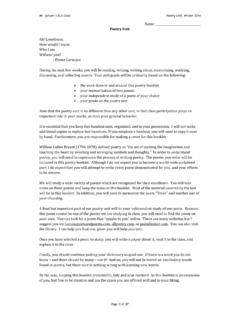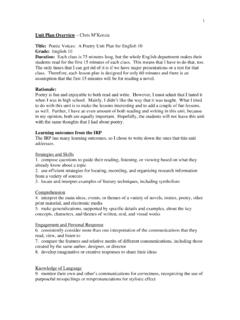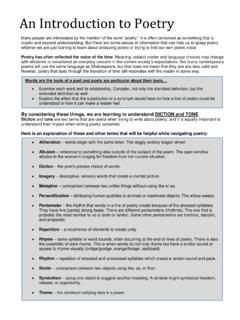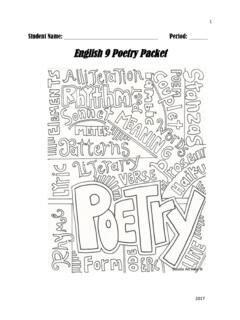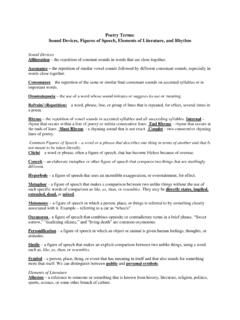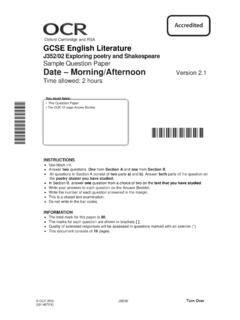Transcription of Grade 9 Poetry Unit - Mr. Sylvain's Classroom
1 Mr. Sylvain s ELA Class Poetry unit , Winter 2014 Page 1 of 36 Name: _____ Grade 9 Poetry unit If you know what you are going to write when you re writing a poem, it s going to be average. Derek Walcott Poetry is an important genre in student writing. It gives opportunities to play with language in novel ways, and sometimes to incorporate art and graphic design skills as well. Understand that it is the message that is important in Poetry , not just the format or rhyming. Playing with line breaks and white space, exploring repetition and font choices for emphasis, and focusing on descriptive language that carries meaning are all ways to enhance (poetic) writing skills. During the next few weeks, you will be reading, writing, writing about, memorizing, studying, discussing, and collecting poems. Your unit Grade will be primarily based on the following: the work done in and around this Poetry booklet your memorization of one poem your Poetry analysis essay your Grade on the Poetry test Note that the Poetry unit is no different than any other unit , in that class participation plays an important role in your marks, as does your general behavior.
2 It is essential that you keep this handout neat, organized. I will not make additional copies to replace lost handouts. If you misplace a handout, you will need to copy it over by hand. Furthermore, you are responsible for making a cover for this booklet. In order to understand Poetry , you will need to experience the process of writing Poetry . The poems you write will be included in this Poetry booklet. Although I do not expect you to become a world-wide acclaimed poet, I do expect that you will attempt to write every poem demonstrated for you, and your efforts to be sincere. As you consider all senses, it is a great opportunity to expand your vocabulary. We will study a wide variety of poems, mostly by Edgar Allan Poe but also others, which are recognized for their excellence. You will take notes on these poems and keep the notes in this booklet. Most of the material covered by the test will be in this booklet. Finally, you should continue putting your dictionary to good use.
3 If there is a word you do not know and there should be many use it! You will not be tested on vocabulary words found in poems, but there sure is nothing wrong with learning new words. By the way, keeping this booklet presentable, tidy and neat matters! As this booklet is an extension of you, feel free to be creative and use the space you are offered well and to your liking. Mr. Sylvain s ELA Class Poetry unit , Winter 2014 Page 2 of 36 TABLE OF CONTENTS Preface 1 Table of Contents 2 Concrete Verse (aka Shape Poetry ) 3 Numerical Poem 6 Acrostic Poem 7 Diamante Poem 8 Haiku Poem 9 Limericks 10 Kyrielle 11 Nonet 12 Minute Poem 13 Monorhyme 14 Narrative Poetry 15 "Stopping by Woods on a Snowy Evening" 18 Mini Biography of Edgar Allan Poe 19 Eldorado 20 A Dream Within a Dream 21 "Lenore" 22 "Annabel Lee" 23 To -- -- --. Ulalume: A Ballad 24 "Sonnet To Science" 25 "The City in the Sea" 26 "The Conqueror Worm" 27 "The Raven" 28 Glossary 31 Poetry Analysis Essay 35 Notes on Poetry studied A1 Comparative Essay Outline A2 Poetry Analysis Essay A3 Mr.
4 Sylvain s ELA Class Poetry unit , Winter 2014 Page 3 of 36 Concrete Verse (aka Shape Poetry ) Picture poems are called concrete poems. They contain words, like other poems but the words are arranged into shapes suggesting an object or idea. The arrangement becomes part of the experience of the poem. Self Portrait The words used for Self Portrait are related to a face. Notice how the arrangement suggests the shape of a face. Here are a few other examples, albeit in a slightly different style. Mr. Sylvain s ELA Class Poetry unit , Winter 2014 Page 4 of 36 Mr. Sylvain s ELA Class Poetry unit , Winter 2014 Page 5 of 36 Concrete poems can be written about any topic. They don t rhyme and don t need any punctuation. Some people say this kind of Poetry is not real Poetry . What is your opinion? Play with ideas for concrete poems, then choose one or two of your best ones and reproduce them here. You can write about an object, about yourself, or any other topic you desire.
5 Whatever inspires you! Mr. Sylvain s ELA Class Poetry unit , Winter 2014 Page 6 of 36 Numerical Poem One Big, Hungry Dog One big, hungry dog Gobbled up two large bones And three cans of dog food At four in the afternoon. By five he had a terrible stomachache. He burped loudly six times And gave seven great groans. He felt better by eight. But then, nine friends came over With ten big steaks. You can have fun writing a poem using numbers. You can do this with a partner if you wish. The first person begins the poem with a line that contains the word one. The second person adds a line with the word two in it, and so on. Continue to take turns until you have ten lines. 1 _____ 2 _____ 3 _____ 4 _____ 5 _____ 6 _____ 7 _____ 8 _____ 9 _____ 10 _____ Mr. Sylvain s ELA Class Poetry unit , Winter 2014 Page 7 of 36 Acrostic Poems An acrostic poem uses the letters of a topic word as the first letter for each line of the poem.
6 Each line of the poem includes words and phrases related to the topic. Acrostic poems can be long or short, but usually do not rhyme. The name of friends, pets, places, or family members can be topics for acrostic poems. Acrostic poems can include the special qualities of the person, place, or animal. People like cats and dogs, but Eagles need to be free. Tigers play rough too rough and Snakes sleep too much. Towering high above us Roots take up the water Evergreens stay green all year Essential to keep beings alive and well Artistically I pen my verse Crafting as I go Romancing every line Ordering the flow Systematically perfected, The verses are refined In every work I labor Concerned with what s defined To write an acrostic poem, start by jotting down words and phrases that begin with each letter of the name. Then decide which words and phrases you want to use. One simple rule is imposed upon you: make sure your word is at least five letters long. Mr.
7 Sylvain s ELA Class Poetry unit , Winter 2014 Page 8 of 36 Diamante Poem Diamante poems begin with one subject and end with another, totally different or opposite subject. Line 1: A noun (Subject 1) Line 2: Two adjectives describing Subject 1 Line 3: Three ing words about Subject 1 Line 4: Four nouns: two related to Subject 1 and two related to Subject 2 Line 5: Three ing words about Subject 2 Line 6: Two adjectives describing Subject 2 Line 7: A noun (Subject 2) Baby Cuddly, helpless Crawling, crying, playing Playpen, blocks, family, career Working, laughing, driving Confident, independent Adult Notice how Line 4 serves as a transition from the first subject to the second one. Follow the format to write one with student as Subject 1 and teacher as Subject 2. Student _____, _____ _____, _____, _____ _____, _____, _____, _____ _____, _____, _____ _____, _____ Teacher Write one of your own about two opposite topics. Polish and proofread your poem before writing the final copy.
8 _____ _____, _____ _____, _____, _____ _____, _____, _____, _____ _____, _____, _____ _____, _____ _____ Mr. Sylvain s ELA Class Poetry unit , Winter 2014 Page 9 of 36 Haiku Poem Haiku is a formal type of Poetry with a very specific pattern: Each poem is only three lines long The first and third lines contain exactly five syllables. The second line contains exactly seven syllables. Haiku Poetry paint word pictures about topics that are often related to nature or to one of the seasons. Writers use haiku to express strong feelings about a topic. Fog Silent fog creeping Out of the October night Smothering the world Storm Overhead the light Is growing ever fainter Thunder splits the deep Shelter It s cold and I wait For someone to shelter me And take me from here To write haiku, first decide on a season and/or something in nature related to that season. You can use your own ideas or one from this list below. A winter blizzard A hot, steamy rain forest A forest on a hot summer night The stillness after a snowstorm A lonely bird shivering in the winter Waves crashing on the shore A spring thunderstorm Mountains covered with snow The ocean, still or stormy A tree without leaves The dry heat of a desert White desert fox Since haiku uses so few words, poets know how important it is to use exactly the right words.
9 A thesaurus is very helpful when writing haiku. Think of three possible topics for your haiku poem. Then add related words and phrases. Use interesting words to paint a word picture or to create a feeling. Finally, polish your haiku(s) and write the final version(s) here. Mr. Sylvain s ELA Class Poetry unit , Winter 2014 Page 10 of 36 Limericks Limericks are five-line poems that use rhythm and rhyme. Line 1, 2, and 5 are longer and end in rhyming words. Limericks are short poems not meant to be taken seriously. They consist of five lines with rhyme scheme AABBA. The pattern of syllable stresses is not set in stone, but it is generally anapestic (unstressed, unstressed, stressed). The first, second, and fifth lines contain nine syllables, while the third and fourth have six. The syllable count is not set in stone, though, as long as lines 3 and 4 are shorter than the other lines. Despite that dry and technical explanation, in reality, limericks are simple and fun to write.
10 There once was a good seventh- Grade lad Whose poems were exceedingly bad. But the only thing worse Than his terrible verse Were the ones that he learned from his dad. A Plane builder needed a pilot, So Bob told the guy, he would try it. When Bob took to the air, Plane parts fell everywhere. Bob radioed where shall I park it? There once was a man from Aruba, Whose favorite hobby was scuba. Every day he would wish, He could spear a big fish. But settled instead for canned tuna. Write two limericks. Revise them several times before you decide to write them in your booklet. Check the rhythm and the rhyme scheme. We will hold a limerick-writing contest and vote for the funniest. Mr. Sylvain s ELA Class Poetry unit , Winter 2014 Page 11 of 36 Kyrielle A kyrielle is a French form of rhyming Poetry written in quatrains (a stanza consisting of 4 lines). Each quatrain contains a repeating line or phrase as a refrain (usually appearing as the last line of each stanza).
